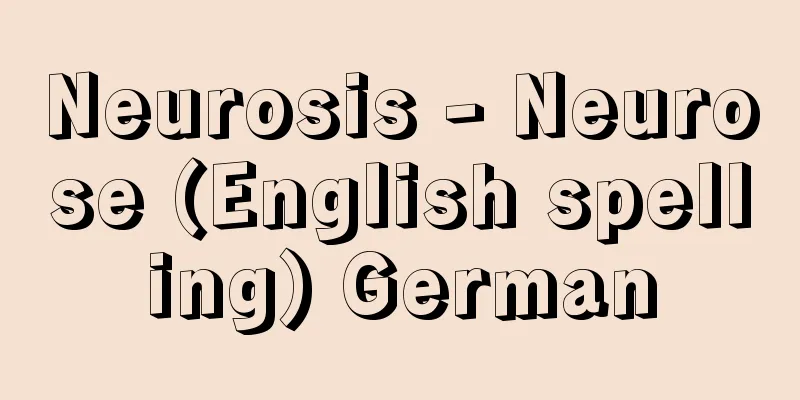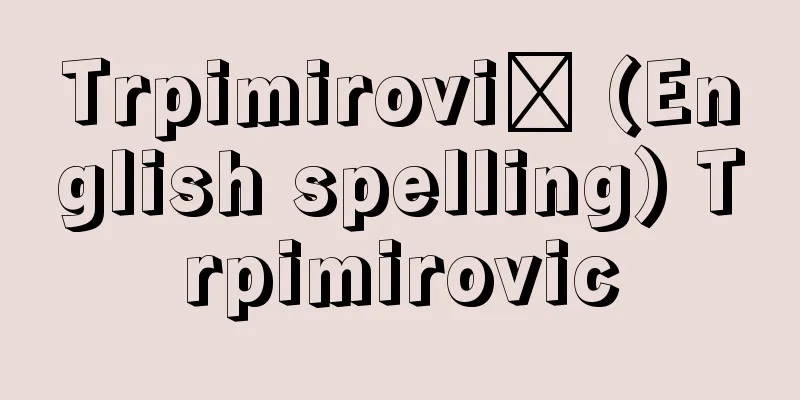Neurosis - Neurose (English spelling) German

|
Traditionally, it was considered to be a mental and physical dysfunction caused by an inability to process anxiety resulting from mental conflict. In addition, although various physical and mental symptoms appear, there are no macroscopic or microscopic abnormal findings that could be the basis for these symptoms. In other words, it was considered to be characterized by being functional, not organic, and by being psychological in origin, that is, psychogenic. However, it has been revealed today that biological causes also exist in cases of anxiety disorders, which will be described later. The term neurosis was coined in 1777 by Scottish physician William Cullen (1710-90), but at the time it had a broader meaning of a nervous system disorder of unknown cause, including Parkinson's disease, and was quite different from what we call neurosis today. In order to establish the concept of neurosis as we know it today, the development of research into psychogenic theory, that is, the involvement of mental causes in the onset of illness, was necessary. Psychogenic theory became clearer when Freud established psychoanalysis after studying hypnosis. Neurosis is called neurose in German, but neurose in the common usage does not have the correct psychiatric meaning, but rather refers broadly to mental disorders and in some cases schizophrenia. It is sometimes used to avoid using the term psychosis. Neurosis differs from psychosis in that the mental symptoms are not as severe, that although daily life may be hindered by neurotic symptoms, the patient does not lose a sense of responsibility or interest in daily life, and that the patient is aware that he or she is in an abnormal state, i.e., has an awareness of the illness. However, when the American Psychiatric Association made a major revision of its diagnostic classification in 1980, it stopped using the term neurosis. This was because the term neurosis was overused and it became clear that what had previously been considered neurosis had biological as well as psychological causes. The ideas of the American Psychiatric Association have influenced the International Classification of Diseases (ICD) of the World Health Organization (WHO), but the term neurotic disorder is used in the ICD. In Japan, while new knowledge is gradually being adopted, there is still a tendency to use the traditional classification. Here, we will focus on the new ideas and discuss the main ones. [Masahisa Nishizono] Panic disorderIt is also called panic disorder. It is roughly equivalent to the acute anxiety state in the conventional anxiety neurosis. Suddenly, the patient is attacked by palpitations, palpitations, increased heart rate, sweating, trembling, shortness of breath, chest tightness, suffocation, chest pain or discomfort, nausea or abdominal discomfort, dizziness, lightheadedness or fainting, a sense of unreality, or depersonalization symptoms, which cause fear of death or mental disorders. These anxiety attacks are now called panic attacks, but even after the attack has subsided, the patient may feel anticipatory anxiety that another attack will occur, which may lead to the fear of going out (agoraphobia). Due to the nature of the attack, it is important to make a differential diagnosis with angina pectoris and myocardial infarction. It has been discovered that symptoms can be alleviated by using antidepressants and anti-anxiety drugs, and conversely, that a certain substance (lactic acid) can be experimentally injected into the body to induce panic attacks. This has led to the recognition that certain neuroses, especially those with traditional symptoms characterized by anxiety, are caused by abnormal neurological activity apart from psychological conflict, that is, that they have a biological basis. Based on this understanding, the American Diagnostic and Statistical Classification of Mental Disorders, Fourth Edition (DSM-IV) lumps all of these disorders together under the category of anxiety disorders. Panic disorder is one of these. [Masahisa Nishizono] Generalized disorderIt corresponds to the chronic anxiety state of conventional anxiety neurosis. (1) Restlessness, tension, irritability, (2) fatigue, (3) difficulty concentrating or going blank, (4) irritability, (5) muscle tension, (6) sleep disorders (difficulty falling asleep or staying asleep). Along with these symptoms, the patient feels excessive anxiety and worry about not being able to adapt to work, school, etc., and finds it difficult to limit themselves. [Masahisa Nishizono] Hypochondriacal DisorderIt is also called hypochondriacal neurosis. It is a group of neuroses in which a person complains of a variety of overlapping physical symptoms. In the American diagnostic classification, it is divided into somatic disorder and hypochondriacal disorder. [Masahisa Nishizono] Conversion disorderIt is also called hysterical neurosis or conversion hysteria. In many cases, it manifests as motor disorders (unable to stand, walk, speak, etc.) or sensory disorders (not being able to see, not feeling pain, persistent pain, etc.), but these are in conflict with the control of the respective nerves. There is also a tendency to use the symptoms as an excuse to avoid gains or responsibilities in family or society (illness gain), but this is not something the individual does intentionally. [Masahisa Nishizono] Dissociative disordersAlso known as dissociative hysteria, symptoms include fugue (forgetting who you are and taking a trip away from family and work), amnesia, multiple personalities (dissociative identity disorder), and depersonalization (losing one's sense of reality about what one is experiencing). [Masahisa Nishizono] Phobic DisorderThe American diagnostic classification includes agoraphobia, fears of certain heights, flying, animals, and social phobias of strangers. [Masahisa Nishizono] Obsessive-compulsive disorderThe individual judges such thoughts, urges and images to be inappropriate and tries to ignore or suppress them, but they continue to be recurrent, persistent and intrusive. The core symptoms are obsessions and compulsions. [Masahisa Nishizono] Post-traumatic stress disorderPost Traumatic Stress Disorder is also known as PTSD. A person with PTSD experiences or witnesses a near-death experience or physical danger, reacts with horror to these experiences, recurrently and intrusively recalls them, feels and acts as if they are happening again (flashbacks), experiences persistent avoidance and general numbness of reactivity in relation to the trauma, and also experiences symptoms of heightened arousal such as sleep disorders, anger, difficulty concentrating, hypervigilance, and excessive startle responses. In Japan, PTSD is generally referred to as "post-traumatic stress disorder," but the DSM-IV does not use the word "psychological." [Masahisa Nishizono] TreatmentNeurosis is generally treated with a combination of drug therapy and psychotherapy, based on the understanding that it is caused by the overlap of biological vulnerability and mental conflict. In particular, anxiety disorders such as panic disorder, generalized anxiety disorder, phobic disorder, hypochondriacal disorder, obsessive-compulsive disorder, and PTSD can be improved with drugs such as anti-anxiety drugs, SSRIs, and SNRIs. However, supportive psychotherapy must also be provided to improve the relationship between the therapist and the patient. Otherwise, the patient may end up doctor shopping or becoming addicted to drugs. Anxiety disorders that do not respond to drugs, such as conversion disorder or dissociative disorder, require full-scale psychotherapy. These include psychoanalytic therapy, behavioral therapy, cognitive therapy, and Morita therapy. These full-scale psychotherapies are performed by specialists who have received specialized training for this purpose, but the difficulty is that most of these specialists are concentrated in large cities and it is difficult, if not impossible, to provide these services under social insurance. [Masahisa Nishizono] "Freud's Collected Works 1: Introduction to Psychoanalysis" translated by Katsumune Kakeda and Yoshitaka Takahashi (1971, Jinbun Shoin)" ▽ "The Current State of Psychiatry by Masahisa Nishizono (2003, Nakayama Shoten)" [References] | | | | | | | | | | | | | | | | | | |Source: Shogakukan Encyclopedia Nipponica About Encyclopedia Nipponica Information | Legend |
|
従来は、精神的葛藤(かっとう)から生じた不安を処理しきれず、心身の機能障害が生じたものをいうとされてきた。また、具体的にはさまざまの身体症状や精神症状が現れるが、それらの症状の根拠になる肉眼的、顕微鏡学的異常所見が認められない、すなわち、器質的でなく機能的であること、そして心理的原因、つまり心因性であることが特徴であるとされてきたが、今日では後述する不安障害などでは生物学的成因も存在することが明らかにされてきている。 神経症という用語は1777年スコットランドの医師カレンWilliam Cullen(1710―90)によって提唱されたものであるが、当時の意味は原因不明の神経系統の障害という幅の広いもので、パーキンソン病なども含まれており、今日でいう神経症とはかなり内容を異にするものであった。今日の神経症概念が確立するにあたっては心因論、つまり、病気の発生に精神的原因が関与するという研究の発展が必要であった。心因論は催眠の研究を経て、フロイトが精神分析を確立したことによって、より明確なものになった。なお、神経症はドイツ語でノイローゼNeuroseというが、通俗的によばれる際のノイローゼは精神医学的な正しい意味ではなくて、広く精神変調、ある場合には統合失調症をさすことが多い。精神病という用語を使うのを避ける気持ちで使われることもある。神経症が精神病と異なるところは、精神症状がそれほど重篤ではないこと、日常生活は神経症症状のために支障されることはあっても、日常生活に対する責任感や関心を失っていないこと、異常な状態にあることに自覚、つまり病識があることなどである。ところが、アメリカ精神医学会では1980年から診断分類を大改訂した際に神経症という病名を使用することを廃止してしまった。それは神経症という用語がいろいろの意味に使われすぎることと、それまで神経症とされてきたもののなかに、原因として心因ばかりでなく生物学的根拠の存在することが明らかになったことによる。このアメリカ精神医学会の考え方は世界保健機関(WHO)の国際疾病分類(ICD)にも影響をあたえているが、ICDのなかでは神経症性障害という用語は使われている。日本では、しだいに新しい知見を取り入れながらも、従来の分類を用いる傾向も残っている。ここでは新しい考え方に比重を置いて、おもなものを述べる。 [西園昌久] 恐慌性障害パニック障害ともいう。従来の不安神経症のなかの急性不安状態にほぼ相当する。突然、動悸(どうき)、心悸亢進(しんきこうしん)、心拍数の増加、発汗、身震い、息切れ感、胸苦しさ、窒息感、胸痛もしくは胸部不快感、吐き気または腹部不快感、めまい感、ふらつき、頭が軽くなる感じあるいは気が遠くなる感じ、現実でない感じ、あるいは自分自身から自分が離れるような離人症状などに襲われ、死の不安、あるいは精神に異常をきたすのではないかという不安にさらされる。この不安発作は、今日ではパニック発作とよばれるが、いったん発作が治まっても、ふたたび発作におそわれはしないかと予期不安がおき、また、そのために外出恐怖(広場恐怖)へと発展することがある。発作の性質から、狭心症や心筋梗塞(しんきんこうそく)症などとの鑑別診断が重要である。抗うつ薬、抗不安薬の使用で症状が軽減すること、逆にある物質(乳酸)を実験的に体内に注入するとパニック発作を誘発することができることが明らかにされて、ある種の神経症、ことに不安を特徴とする従来の症状をもつ神経症には心理的葛藤とは別に神経の異常活動に原因があること、つまり生物学根拠の存在が認められるようになった。そのような理解をもとにアメリカの精神科診断分類第4版(DSM‐Ⅳ)では不安障害で一括している。恐慌性障害はそのなかの一つである。 [西園昌久] 全般性障害従来の不安神経症の慢性不安状態に相当する。(1)落ち着きのなさ、または緊張感、過敏、(2)疲労しやすさ、(3)集中困難または心が空白になること、(4)易刺激性、(5)筋肉の緊張、(6)睡眠障害(入眠、または睡眠維持の困難)、これらの症状を伴って、仕事や学業などに適応できないと過剰な不安と心配をし、自身では制限することが難しいと感じているものである。 [西園昌久] 心気性障害心気神経症ともいう。からだについての多彩な症状を重ねて訴える一群の神経症。アメリカの診断分類では身体化障害と心気症とに分けられている。 [西園昌久] 転換性障害ヒステリー神経症あるいは転換ヒステリーともいう。多くの場合、運動障害(立てない、歩けない、話せないなど)や知覚障害(見えない、痛くない、頑固な疼痛(とうつう)など)として現われるが、それぞれの神経支配とは矛盾する。また、症状を理由にして家族や社会での利得や責任を免れようとする傾向(疾病利得)がみられるが、それらは本人が意図的に行っているわけではない。 [西園昌久] 解離性障害あるいは解離ヒステリーともいう。遁走(とんそう)(自分が誰であるか忘れてしまって、家族や職場から離れる旅をすること)、健忘、いわゆる多重人格(解離性同一性障害)、離人症(体験していることについての実感がなくなる)など。 [西園昌久] 恐怖性障害アメリカの診断分類では、広場恐怖、ある特定の高所、飛行、動物などを対象とした恐怖、よく知らない人を対象にした社会恐怖が含まれている。 [西園昌久] 強迫性障害本人は、そのような思考、衝動、イメージは不適切と判断し、無視あるいは抑制しようと試みるが、反復的持続的にある思考、衝動、イメージが侵入的に起きてくる。中心をなす症状は強迫観念と強迫行為である。 [西園昌久] 外傷後ストレス障害Post Traumatic Stress Disorderを略してPTSDともいう。死に直面するような出来事、身体の危険にさらされる体験を自ら体験、あるいは目撃、それらに対する戦慄の反応をし、それが反復的、侵入的に想起されたり、再び起きているかのように感じたり行動したり(フラッシュバック)、外傷と関連して持続的回避と全般的な反応性の麻痺を認め、さらに睡眠障害、怒り、集中困難、過度の警戒心、過剰な驚愕(きょうがく)反応などの覚醒亢進(かくせいこうしん)症状が存在する。なお、日本ではPTSDを一般的に「心的外傷後ストレス障害」とよぶことがあるが、DSM‐Ⅳでは「心的」は使っていない。 [西園昌久] 治療神経症の治療は、生物学的な脆弱(ぜいじゃく)性と精神的葛藤とが重なりあって発病するという理解にたって、薬物療法と精神療法とを併用するのが一般的である。ことに、不安障害に属するパニック障害、全般性不安障害、恐怖性障害、心気性障害、強迫性障害、PTSDなどは、抗不安薬、SSRI、SNRIなどの薬剤で症状改善が得られることが期待される。しかし同時に、治療者と患者の関係がよくなるよう支持的精神療法もなされねばならない。そうでないと医師を転々とするドクターショッピングや薬物依存が生じてしまう。薬の効果のない不安障害に属するもの、転換性障害あるいは解離性障害には本格的な精神療法が必要である。精神分析療法、行動療法、認知療法、森田療法などである。それらの本格的精神療法は、そのための専門的訓練を受けた専門家によってなされるが、そのほとんどの人が大都会に偏っているのと社会保険診療では不可能でないにしても困難であるのが難点である。 [西園昌久] 『懸田克躬・高橋義孝訳『フロイト著作集1 精神分析入門』正続(1971・人文書院)』▽『西園昌久著『精神医学の現在』(2003・中山書店)』 [参照項目] | | | | | | | | | | | | | | | | | | |出典 小学館 日本大百科全書(ニッポニカ)日本大百科全書(ニッポニカ)について 情報 | 凡例 |
<<: Neuropsychology - Shinkeishinrigaku
Recommend
Dragon slaying - Ryutaij
This ancient story is widely known around the worl...
Terra Amata (English spelling)
…Many ruins, including some caves, are known, but...
Ganja (plant) - Ganja
… [Mitsuru Hotta] [Cannabis Addiction] It refers ...
Suga (moth nest) - Suga
A general term for insects belonging to the Lepido...
Declaration of war - kaisensengen
…In the wake of criticism of the 1904 Russo-Japan...
Kingdom of Swaziland
A small kingdom of the Swazi people in the 19th ce...
Nikolay Vladimirovich Stankevich
1813‐40 Russian thinker and poet. A leading figure...
Okushiga
...In 1970, the 41km stretch connecting Kanbayash...
Clasp - Clasp
〘noun〙① A metal fitting for fastening a door. A la...
Horse mackerel
…It can also be read as “aji.” In ancient Okinawa...
Pistachio (English spelling) Pistacia vera; pistachio
A deciduous tree of the Anacardiaceae family. It i...
Stone Buddha
A general term for Buddha statues carved into sto...
Red sea hoya
One of the special soils scattered throughout Kyus...
Kanpyo (dried gourd) - Kanpyo
Bottle gourd flesh is peeled into thin, long strip...
Eikoin Temple
…For this reason, he did not have any children, a...




![Ichiu [village] - Ichiu](/upload/images/67caec2d5dbff.webp)




